Great Italian artist and inventor of the Renaissance Leonardo da Vinci was born on April 15, 1452 in the small village of Anchiano LU, located near the town of Vinci FI. He was the illegitimate son of a wealthy notary, Piero da Vinci, and a beautiful village woman, Katarina. Soon after this event, the notary entered into marriage with the girl noble birth. They had no children, and Piero and his wife took their three-year-old child with them.
The Birth of an Artist
The brief period of childhood in the village is over. Notary Piero moved to Florence, where he apprenticed his son to Andrea del Veroccio, a famous Tuscan master. There, in addition to painting and sculpture, the future artist had the opportunity to study the basics of mathematics and mechanics, anatomy, working with metals and plaster, and methods of tanning leather. The young man greedily absorbed knowledge and later widely used it in his activities.
An interesting creative biography of the maestro belongs to the pen of his contemporary Giorgio Vasari. In Vasari's book "Life of Leonardo" there is Short story about how Andrea del Verrocchio recruited a student to carry out the order “The Baptism of Christ” (Battesimo di Cristo). The angel painted by Leonardo so clearly demonstrated his superiority over his teacher that the latter threw down his brush in frustration and never painted again.
The qualification of a master was awarded to him by the Guild of St. Luke. Next year Leonardo da Vinci spent his life in Florence. His first mature painting is “The Adoration of the Magi” (Adorazione dei Magi), commissioned for the monastery of San Donato.
Milanese period (1482 - 1499)
Leonardo came to Milan as a peace envoy from Lorenzo di Medici to Lodovico Sforza, nicknamed Moro. Here his work received a new direction. He was enrolled in the court staff first as an engineer and only later as an artist.
The Duke of Milan, a cruel and narrow-minded man, had little interest in the creative component of Leonardo’s personality. The master was even less worried about the duke's indifference. Interests converged in one thing. Moreau needed engineering devices for military operations and mechanical structures for the entertainment of the court. Leonardo understood this like no one else. His mind did not sleep, the master was sure that human capabilities are limitless. His ideas were close to the humanists of the New Age, but in many ways incomprehensible to his contemporaries.
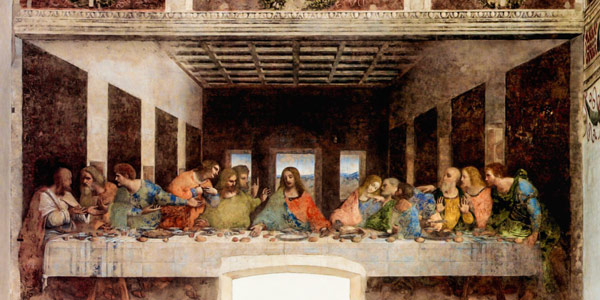
Two belong to the same period important work– (Il Cenacolo) for the refectory of the monastery of Santa Maria della Grazie (Chiesa e Convento Domenicano di Santa Maria delle Grazie) and the painting “Lady with an Ermine” (Dama con l’ermellino).
![]()
The second is a portrait of Cecilia Gallerani, the favorite of the Duke of Sforza. The biography of this woman is unusual. One of the most beautiful and learned ladies of the Renaissance, she was simple and kind, and knew how to get along with people. An affair with the Duke saved one of her brothers from prison. She had the most tender relationship with Leonardo, but, according to contemporaries and the opinion of most researchers, they brief connection remained platonic.
A more common (and also not confirmed) version is about the master’s intimate relationship with his students Francesco Melzi and Salai. The artist preferred to keep the details of his personal life a deep secret.
Moro commissioned the master to create an equestrian statue of Francesco Sforza. The necessary sketches were completed and a clay model of the future monument was made. Further work prevented the French invasion of Milan. The artist left for Florence. He will return here again, but to another master - the French king Louis XII.
Again in Florence (1499 - 1506)
His return to Florence was marked by his entry into the service of Duke Cesare Borgia and the creation of his most famous painting, Gioconda. The new work required frequent travel; the master traveled around Romagna, Tuscany and Umbria on various assignments. His main mission was reconnaissance and preparation of the area for military operations by Cesare, who planned to subjugate the Papal States. Cesare Borgia was considered the greatest villain of the Christian world, but Leonardo admired his tenacity and remarkable talent as a commander. He argued that the Duke's vices were balanced by "equally great virtues." The ambitious plans of the great adventurer did not come true. The master returned to Milan in 1506.
Later years (1506 - 1519)
The second Milanese period lasted until 1512. The Maestro studied the structure of the human eye, worked on the monument to Gian Giacomo Trivulzio and his own self-portrait. In 1512 the artist moved to Rome. Giovanni di Medici, the son of Lorenzo the Magnificent, was elected pope and took office under the name of Leo X. The pope's brother, Duke Giuliano di Medici, highly appreciated the work of his compatriot. After his death, the master accepted the invitation of King Francis I (François I) and left for France in 1516.

Francis turned out to be the most generous and grateful patron. The maestro settled in the picturesque castle of Clos Lucé in Touraine, where he had every opportunity to do what was interesting to him. By royal commission, he designed a lion from whose chest a bouquet of lilies opened. The French period was the happiest of his life. The king assigned his engineer an annual annuity of 1000 ecus and donated land with vineyards, ensuring him a peaceful old age. The maestro's life was cut short in 1519. He bequeathed his notes, instruments and estates to his students.
Paintings


Inventions and works
Most of the master's inventions were not created during his lifetime, remaining only in notes and drawings. An airplane, a bicycle, a parachute, a tank... He was possessed by the dream of flight, the scientist believed that a person can and should fly. Studied bird behavior and sketched wings different forms. His design for a two-lens telescope is surprisingly accurate, and in his diaries there is a brief entry about the possibility of “seeing the Moon big.”
As a military engineer he was always in demand; the lightweight saddle bridges he invented and the wheel lock for a pistol were used everywhere. He dealt with the problems of urban planning and land reclamation, and in 1509 he built the St. Christopher, as well as the Martesana irrigation canal. The Duke of Moreau rejected his project for an “ideal city”. Several centuries later, the development of London was carried out according to this project. In Norway there is a bridge built according to his drawing. In France, already an old man, he designed a canal between the Loire and Saône.
Leonardo's diaries are written in easy, lively language and are interesting to read. His fables, parables and aphorisms speak of the versatility of his great mind.
The secret of genius
There were plenty of secrets in the life of the Renaissance titan. The main one opened relatively recently. But has it opened? In 1950, a list of Grand Masters of the Priory of Sion (Prieuré de Sion), a secret organization created in 1090 in Jerusalem, was published. According to the list, Leonardo da Vinci was the ninth of the Grand Masters of the Priory. His predecessor in this amazing post was Sandro Botticelli, and his successor was Constable Charles III de Bourbon. The main goal of the organization was to restore the Merovingian dynasty to the throne of France. The Priory considered the offspring of this family to be the descendants of Jesus Christ.
Existence itself similar organization raises doubts among most historians. But such doubts could have been sown by members of the Priory who wished to continue their activities in secret.
If we accept this version as the truth, the master’s habit of complete independence and the strange attraction for France for a Florentine become clear. Even Leonardo's writing style - left hand and right to left - can be interpreted as an imitation of Hebrew writing. This seems unlikely, but the scale of his personality allows us to make the most daring assumptions.
Stories about the Priory cause distrust among scientists, but enrich artistic creativity. Most shining example– Dan Brown’s book “The Da Vinci Code” and the film of the same name.
- At the age of 24, together with three Florentine youths was accused of sodomy. The company was acquitted due to lack of evidence.
- Maestro was a vegetarian. People who consume animal food were called “walking cemeteries.”
- He shocked his contemporaries with his habit of carefully examining and sketching the hanged in detail. Exploring the device human body considered it the most important activity.
- There is an opinion that the maestro developed tasteless and odorless poisons for Cesare Borgia and wiretapping devices made of glass tubes.
- Television mini-series "The Life of Leonardo da Vinci"(La vita di Leonardo da Vinci), directed by Renato Castellani, received a Golden Globe award.
- named after Leonardo da Vinci and is decorated with a huge statue depicting a master with a model of a helicopter in his hands.
Leonardo da Vinci. Mona Lisa (fragment). 1503-1519 Louvre, Paris
Leonardo da Vinci is the most famous artist in the world. Which in itself is surprising. There are only 19 surviving paintings by the master. How is this possible? Does two dozen works make an artist the greatest?
It's all about Leonardo himself. He is one of the most unusual people ever born. Inventor various mechanisms. Discoverer of many phenomena. Virtuoso musician. And also a cartographer, botanist and anatomist.
In his notes we find descriptions of a bicycle, a submarine, a helicopter and a tanker. Not to mention scissors, a life jacket and contact lenses.
His innovations in painting were also incredible. He was one of the first to use oil paints. Sfumato effect and cut-off modulation. He was the first to incorporate figures into the landscape. His models in portraits became living people, not painted mannequins.
Here are just 5 masterpieces of the master. Which demonstrate the genius of this man.
1. Madonna of the Rocks. 1483-1486

Leonardo da Vinci. Madonna of the Rocks. 1483-1486 Louvre, Paris. Wikimedia.commons.org
Young Virgin Mary. Pretty Angel in a red cloak. And two well-fed children. The Holy Family with the baby Jesus were returning from Egypt. Along the way we met little John the Baptist.
This is the first picture in the history of painting when people are depicted not in front of the landscape, but inside it. The heroes are sitting by the water. Behind the rock. So old that they look more like staloctites.
The “Madonna of the Rocks” was commissioned by the monks of the Brotherhood of St. Francis for one of the Milan churches. But the customers were not happy. Leonardo was late with deadlines. They also didn't like the lack of halos. The angel's gesture also confused them. Why is it his forefinger directed at John the Baptist? After all, baby Jesus is more important.
Leonardo sold the painting on the side. The monks got angry and filed a lawsuit. The artist was obliged to paint a new picture for the monks. Only with halos and without the angel's pointing gesture.
By official version This is how the second “Madonna of the Rocks” appeared. Almost identical to the first one. But there is something strange about it.
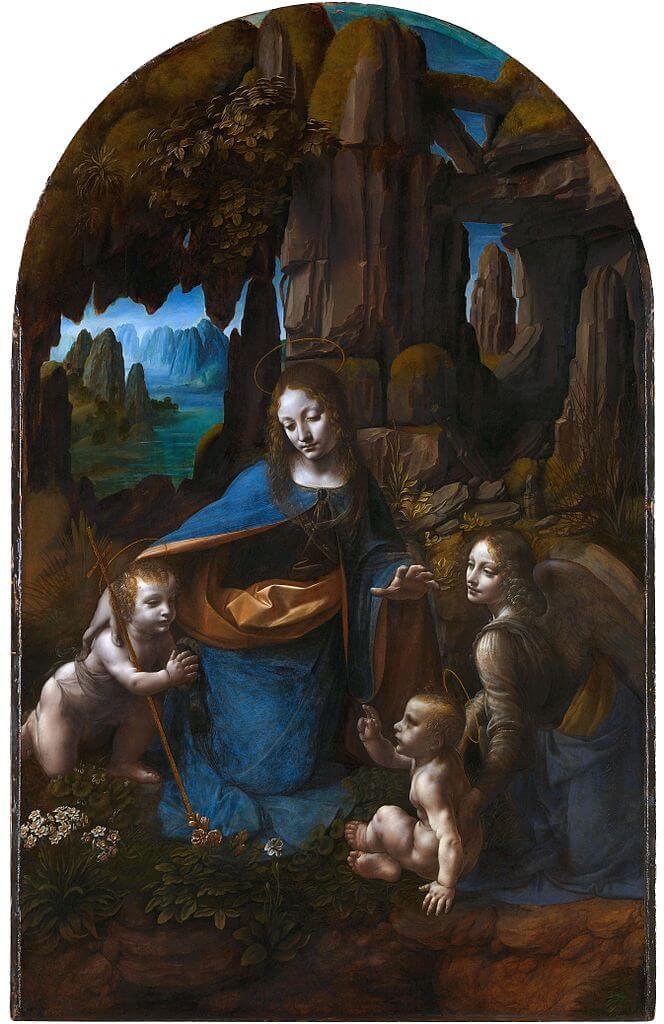
Leonardo da Vinci. Madonna of the Rocks. 1508 National Gallery London.
Leonardo carefully studied the plants. He even made a number of discoveries in the field of botany. It was he who realized that tree sap plays the same role as blood in human veins. I also figured out how to determine the age of trees by their rings.
Therefore, it is not surprising that the vegetation in the Louvre painting is realistic. These are the plants that grow in a damp, dark place. But in the second picture the flora is fictitious.
How did Leonardo, so truthful in his depiction of nature, suddenly decide to fantasize? In a single picture? Unthinkable.
I think Leonardo was not interested in painting a second picture. And he instructed his student to make a copy. Who obviously didn’t understand botany.
2. Lady with an ermine. 1489-1490
Leonardo da Vinci. Lady with an ermine. 1489-1490 Czertoryski Museum, Krakow. Wikimedia.commons.org
Before us is young Cecilia Gallerani. She was the mistress of the ruler of Milan, Ludovico Sforza. At whose court Leonardo also served.
Smiling, good-natured and a smart girl. She was an interesting conversationalist. He and Leonardo talked often and for a long time.
The portrait is very unusual. Leonardo's contemporaries painted people's profiles. Here Cecilia stands in three quarters. Turning your head in the opposite direction. It was as if she was looking back at someone's words. This spread makes the shoulder line and neck especially beautiful.
Alas, we see the portrait in an altered form. One of the owners of the portrait darkened the background. Leonardo's was lighter. With a window behind the girl's left shoulder. The two lower fingers of her hand are also rewritten. That's why they are curved unnaturally.
It is worth talking about the ermine. Such an animal seems like a curiosity to us. To modern man it would be more common to see a fluffy cat in a girl’s hands.
But for the 15th century, it was the ermine that was an ordinary animal. They were kept to catch mice. And cats were just exotic.
3. Last Supper. 1495-1598

Leonardo da Vinci. Last Supper. 1495-1498 Monastery of Santa Maria delle Grazia, Milan
The Last Supper fresco was commissioned by the same Ludovico Sforza at the request of his wife Beatrice d’Este. Alas, she died very young during childbirth. Never saw the painting completed.
The Duke was beside himself with grief. Realizing how dear his cheerful and beautiful wife was to him. The more he was grateful to Leonardo for the work done.
He paid the artist generously. Handing him 2,000 ducats (about 800 thousand dollars in our money), and also giving him ownership of a large plot of land.
When the residents of Milan were able to see the fresco, amazement knew no bounds. The apostles differed not only in appearance, but also in their emotions and gestures. Each of them reacted in their own way to Christ’s words, “One of you will betray me.” Never before has the individuality of the characters been so clearly expressed as in Leonardo.
There is another mural amazing detail. Restorers found that Leonardo painted the shadows not in gray or black, but in blue! This was unthinkable until the mid-19th century. When they began to write colored shadows.
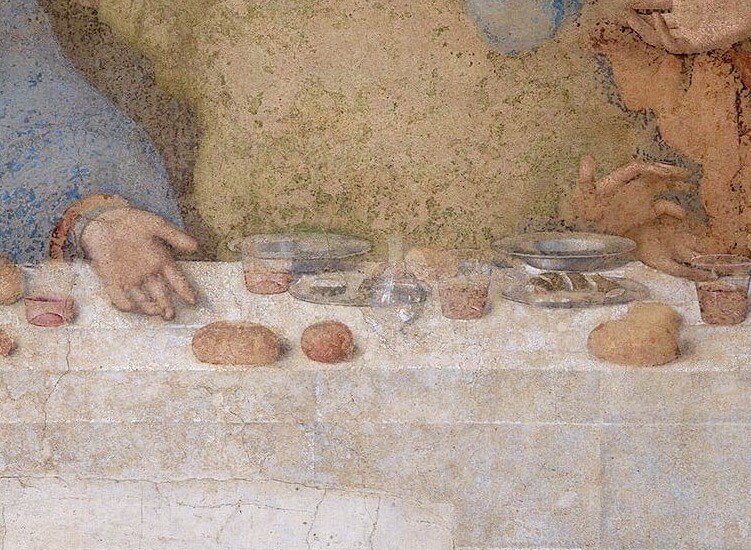
Leonardo da Vinci. Fragment from The Last Supper. 1495-1498 Monastery of Santa Maria delle Grazia, Milan
This is not so clearly visible in the reproduction, but the composition of the paint speaks for itself (blue crystals of copper acetate).
Read about other unusual details of the painting in the article
4. Mona Lisa. 1503-1519
Leonardo da Vinci. Mona Lisa. 1503-1519 Louvre, Paris. Wikimedia.commons.org
In the portrait we see Lisa Gherardini, the wife of a Florentine silk merchant. This version is official, but doubtful.
One curious description of this portrait has reached us. It was left by Leonardo's student, Francesco Melzi. And the Louvre lady does not fit this description at all. I wrote about this in detail in the article .
Now another version of the woman’s identity is being considered. This may be a portrait of Giuliano de' Medici's mistress from Florence. She bore him a son. And soon after giving birth she died.
Giuliano ordered a portrait from Leonardo especially for the boy. In the image of the ideal mother Madonna. Leonardo painted the portrait according to the customer's words. Mixing into them the features of his student Salai.
That is why the Florentine Lady is so similar to “John the Baptist” (see the next picture). For which the same Salai posed.
In this portrait, the sfumato method is revealed to the maximum. A barely perceptible haze, shading the lines, makes the Mona Lisa almost alive. It seems that her lips are about to part. She will sigh. The chest will rise.
The portrait was never given to the customer. Since Giuliano died in 1516. Leonardo took him to France, where he was invited by King Francis I. He last day continued to work on it. Why did it take so long?
Leonardo perceived time completely differently. He was the first to argue that the Earth is much older than commonly thought. He did not believe that the biblical flood brought shells to the mountains. Realizing that in place of the mountains there was once a sea.
Therefore for him it was business as usual painting a picture for decades. What is 15-20 years compared to the age of the Earth!
5. John the Baptist. 1514-1516
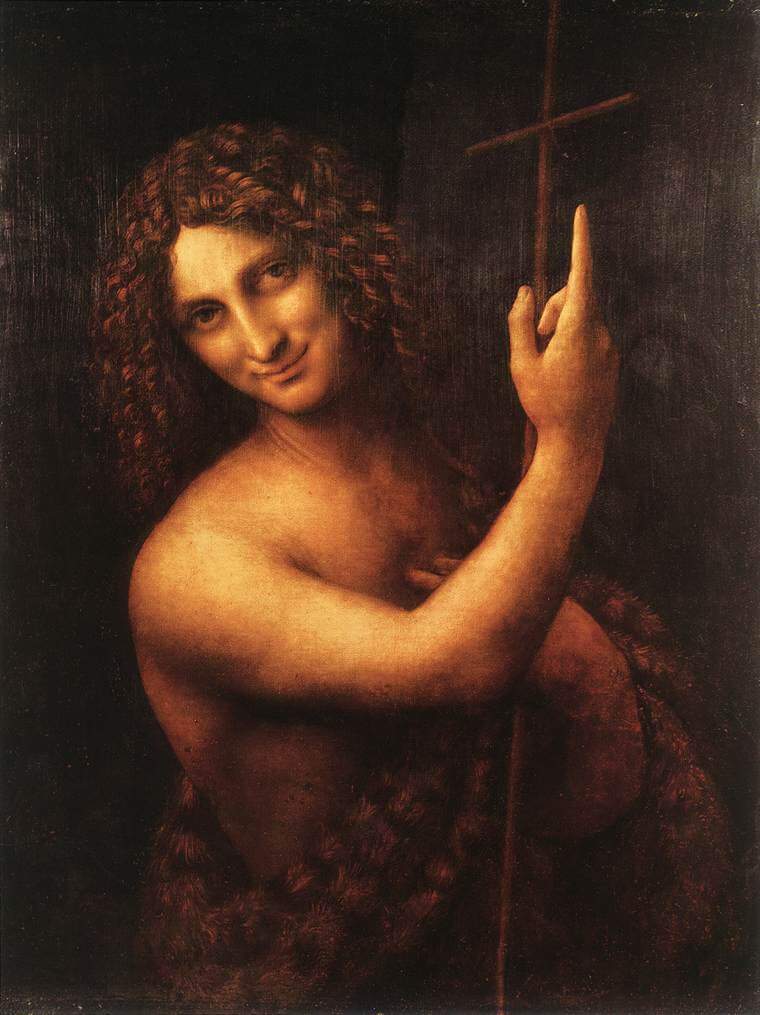
Leonardo da Vinci. Saint John the Baptist. 1513-1516 Louvre, Paris. wga.hu
"John the Baptist" caused bewilderment among Leonardo's contemporaries. Deaf dark background. While even Leonardo himself loved to place figures against the backdrop of nature.
The figure of a saint emerges from the darkness. But it’s difficult to call him a saint. Everyone got used to the elderly John. And then the pretty young man bowed his head meaningfully. A gentle touch of a hand to the chest. Well-groomed curls of hair.
The last thing you think about is holiness when you look at this effeminate man in leopard skin.
Don't you think that this painting doesn't seem to belong at all? It's more like the 17th century. The hero's mannerisms. Theatrical gestures. Contrast of light and shadow. All this comes from the Baroque Age.
Did Leonardo look into the future? Predicting the style and manner of painting of the next century.
Who was Leonardo? Most know him as an artist. But his genius is not limited to this calling.
After all, he was the first to explain why the sky is blue. He believed in the unity of all life in the world. Anticipating the theorists of quantum physics with their “butterfly effect”. He realized such a phenomenon as turbulence. 400 years before its official opening.
By 1514 - 1515 refers to the creation of the masterpiece of the great master - “La Gioconda”.
Until recently, they thought that this portrait was painted much earlier, in Florence, around 1503. They believed the story of Vasari, who wrote: “Leonardo undertook to make for Francesco del Gioconda a portrait of Monna Lisa, his wife, and, having worked on it for four years, left it unfinished. This work is now in the possession of the French king in Fontainebleau. By the way, Leonardo resorted to the following technique: since Madonna Lisa was very beautiful, while painting the portrait he held people who played the lyre or sang, and there were always jesters who kept her cheerful and removed the melancholy that she usually conveys. painting for portraits."
This entire story is wrong from beginning to end. According to Venturi, “Monna Lisa, later Gioconda, was the creation of the fantasy of the short story writer, Aretina biographer, Giorgio Vasari.” Venturi in 1925 suggested that "La Gioconda" is a portrait of the Duchess Costanza d'Avalos, the widow of Federigo del Balzo, glorified in a small poem by Eneo Irpino, which also mentions her portrait painted by Leonardo. Costanza was the mistress of Giuliano de' Medici, who, after marrying Philibertia of Savoy gave the portrait back to Leonardo.
At the very Lately Pedretti put forward a new hypothesis: the Louvre portrait depicts the widow of Giovanni Antonio Brandano, named Pacifica, who was also the mistress of Giuliano de' Medici and bore him a son, Ippolito, in 1511.
Be that as it may, Vasari's version is questionable simply because it does not explain in any way why the portrait of Francesco del Giocondo's wife remained in Leonardo's hands and was taken by him to France.
2. Lady with an ermine ca. 1488-1490
Oil on the panel.
54.8 x 40.3 cm
Czartor Museum, Krakow, Poland
“The Lady with an Ermine” is the immortal seventeen-year-old Cecilia Gallerani, the favorite of Lodovico Sforza. Daughter of the 15th century. Crafty enchantress. Favorite of the Milan Palace. Tender and wise, bashful and frivolous, she appears before us. Simple and complex. Mysteriously attractive, with an almost static face, she still possesses the magnetism of extraordinary, hidden movement. But what gives the young lady’s appearance this magical liveliness? Smile. She barely touched the corners of her chaste lips. It lurked in the slightly swollen girlish dimples near the mouth and, like lightning, flashed in response in the dark, dilated pupils, covered with rounded, onion-shaped eyelids. Take a closer look at the subtle, spiritual features of the “Lady with an Ermine”, at her dignified posture, at her strict but elegant clothes, and the Renaissance with its magnificent creations of brilliant masters of art will instantly appear before you. Cecilia Gallerani. She, like a small planet, reflected the radiance of the cruel, ugly and beautiful, unique 15th century.
3. Fresco The Last Supper 1494 -1498
Oil and tempera on plaster.
460 x 880 cm
Santa Maria del Grazia, Milan, Italy
From left to right, a table with food stretches across the entire width of the picture. Twelve characters sit at the table facing us in groups of three with Christ in the center. The apostles are chatting animatedly. What are they talking about and what is the picture about? From Ammoreti's testimony it should be concluded that the painting "The Last Supper" was completed in 1497. Unfortunately, Leonardo da Vinci painted it with paints, some of which turned out to be very fragile. Fifty years after its completion, the painting, according to Vasari, was in the most pitiful condition. However, if at that time it was possible to fulfill the desire of King Francis I, expressed sixteen years after the completion of the painting, and, having broken down the wall, transfer the painting to France, then perhaps it would have been preserved. But this could not be done. In 1500, the water that flooded the meal completely ruined the wall. In addition, in 1652, a door was broken in the wall under the face of the Savior, destroying the legs of this figure. The painting was unsuccessfully restored several times. In 1796, after the French crossed the Alps, Napoleon gave strict orders to spare the meal, but the generals who followed him, not paying attention to his order, turned this place into a stable, and subsequently into a storage area for hay .
4. Portrait of Ginevra de Benci ca. 1475 - 1478
Tempera and oil on panel
38.1 x 37 cm
National Gallery of Art, Washington
This painting, now in the National Gallery of Art in Washington, depicts a young lady against the backdrop of a mountainous landscape, with reflexes from the river playing on it. There are different points of view regarding the identification of the person being portrayed; Experts' opinions about the dating of this work are also divided. Some attribute it to the first Florentine period of Leonardo’s work, others, on the contrary, to the Milanese period. Most researchers adhere to the hypothesis that the portrait represents Ginevra Benci (her name is hinted at by the branches of the juniper, ginepro, which are visible in the background of the composition). It was made during the period when Leonardo freed himself from his apprenticeship to the art of Verrocchio, that is, around 1475.
5. Portrait of a musician 1485-1490
Oil on the panel.
43 x 31 cm
Ambrosiano Library, Milan, Italy
Portraits attributed to Leonardo contain common features: their background is darkened, a semi-figured image of the model, usually in a three-quarter turn, helps to present it to the viewer in all its individual character. The names of those portrayed are unknown, despite all the efforts of art historians to reveal them, and documentary evidence of the master’s activities. A number of Leonardo's portraits are associated with the atmosphere of the Sforza court, where the glorification of the individual, reflecting the glory of the court, played a decisive role. The purity of forms, the dignity of poses, combined with a keen insight into the character of the model, bring the artist’s portraits closer to the most advanced achievements in this genre of art for that time - with the works of Antonello da Messina. They go far beyond the memorial formalism of the masters of the 15th century, developing a type of portrait that embodies the character’s state of mind and allows one to significantly deepen the characterization of the image. In the so-called Portrait of a Musician from the Ambrosiana in Milan, his model is sometimes identified with the regent of Milan Cathedral, Franchino Gaffurio, but in fact it shows simply a young man with a sheet of music paper. We can also discern some geometricism in the rendering of plastic volumes, revealing the Tuscan influence. The cap on the head and the mass of curly hair form two hemispheres on the sides of the face; the sharpness of the contours and chiaroscuro already indicate the master’s familiarity with Lombard traditions and portraits of Antonello da Messina. Heavily restored, rewritten, and perhaps even left unfinished, although at a fairly advanced stage of work, this is Leonardo's only portrait of a man - if indeed it is by the artist himself - depicts a man with an intelligent and strong gaze. Without being carried away by rhetorical glorification of the individual, Leonardo conveys in the inner light of the face and gaze of the person being portrayed his inherent moral strength.
6. Madonna with a Flower (Benois Madonna) 1478 - 1480
Oil transferred from board to canvas
48x31.5 cm
Hermitage, St. Petersburg, Russia
The young artist Leonardo da Vinci, who had just completed his studies, painted this picture in Florence in the late seventies of the fifteenth century. It was received with enthusiasm, many copies were made, and at the beginning of the sixteenth century... it was lost.
Three hundred years later, a troupe of traveling actors toured in Astrakhan. One of Melpomene’s servants suggested that the local muses-fan and the city’s richest merchant, Alexander Sapozhnikov, buy a painting, darkened with age, written on a board. The deal was completed.
Many years later, his granddaughter Maria got married. The luxurious addition included a creation by an unknown Italian, which at first few people paid attention to. It is unknown what would have happened to him if Maria Alexandrovna’s husband had not become a successful architect and future president Academy of Arts Leonty Benois (son of an even more famous architect) and if he younger brother was not the famous artist, art critic and organizer of the World of Art association Alexander. “Heeding the persistent requests of brother Leonty and his wife,” he recalls, “I had to stay in Berlin. The fact is that they instructed me to show a painting they owned to the famous Bode." (In parentheses, we note that Bode is one of the main authorities on the history of European art, director of the State Berlin Museums). He was absent, but several world-famous specialists were in the museum "Their verdict was harsh: the painting is not a work of Leonardo; rather, it was painted by one of his fellow students in Verrocchio's workshop. Later, Bode himself confirmed this conclusion."
The “Madonna” lay for a whole year from the Sapozhnikovs’ house in Alexander Nikolaevich’s Parisian apartment, and then was taken by him back to St. Petersburg and returned to the owners. However, after eight years (this was already in 1914), when he was in the bustle and troubles associated with preparing the Russian exhibition in Paris, he was given business card with the name of one of the Berlin specialists: “Professor Moller Walde.”
“Before I had time to agree to accept him,” said Alexander Benois, “his own person came at me shouting: “Now I am firmly convinced that your Madonna is Leonardo!” Immediately, without sitting down, without letting me come to my senses, red with excitement, he began to pull out from a huge, tightly stuffed briefcase a pile of photographs of those undoubted drawings by Leonardo, which were in his eyes (and in reality) confirmation of his confidence in the authorship of the great master.
Benois refused the proposal to sell the masterpiece to Berlin museums, transferring it to the collection of the Imperial Hermitage. There the painting remains to this day, known throughout the world under the name “Benois Madonna”.
7. Madonna in the Grotto 1483-1486
Oil on panel (transferred to canvas)
199 x 122 cm
Louvre, Paris, France
The painting was intended to decorate the altar (the frame for the painting was a carved wooden altar) in the Immacolata Chapel of the Church of San Francesco Grande in Milan. On April 25, 1483, members of the Brotherhood of the Holy Conception ordered paintings (the central composition is the Madonna and Child, the side compositions are Angels Playing Music) by Leonardo, who was entrusted with the execution of the most important part of the altar, as well as by the brothers Ambrogio and Evangelista de Predis. Currently, art historians are of the opinion that both canvases on an identical subject, one of which is kept in the Louvre, and the other in the National Gallery in London, are versions of the painting, executed for the same purpose. The signed Madonna of the Rocks from Paris (Louvre) originally decorated the altar of the Church of San Francesco Grande; perhaps it was given by Leonardo himself to the French king Louis XII as a sign of gratitude for mediation in the conflict between customers and artists over payment for paintings. It was replaced in the altar by a composition now located in London. For the first time, Leonardo was able to solve the problem of merging human figures with landscape, which gradually occupied leading place in his art program.
8. John the Baptist 1512
Oil on panel
69 x 57 cm
Louvre, Paris
One might think that the artist's first idea was to depict an angel of the gospel, if only this is consistent with a strange figure that evokes in the viewer a feeling of awkwardness rather than ecstatic amazement. In it we can discern the same spirit of irony that is characteristic of Gioconda, but there is no landscape onto which this irony could be projected, reflecting more complex connections between man and nature. Because of this, John the Baptist makes a strange, even ambiguous impression on the viewer. Meanwhile, the painting certainly belongs to the circle of Leonardo’s works, and in its design it is one of the most innovative, since in the figure of St. John the master synthesized his search for means of expressing feelings and the nature of man in general. Loaded with symbolism and illusion, this image seems to exist on the edge of mystery and reality.
9. Leda with a swan 1508 - 1515
Oil on the panel.
130 x 77.5
Ufizi Gallery, Florence, Italy
The Mona Lisa was created at a time when Leonardo Vinci was so absorbed in studying the structure of the female body, anatomy and problems associated with childbirth that it was almost impossible to separate his artistic and scientific interests. During these years, he sketched a human embryo in the uterus and created the last of several versions of the painting “Leda” based on the ancient myth of the birth of Castor and Pollux from the union of the mortal girl Leda and Zeus, who took the form of a swan. Leonardo studied comparative anatomy and was interested in analogies between all organic forms.
10. Self-portrait 1514 - 1516
Red sanguine (chalk).
33.3 x 21.3 cm
National Gallery in Turin, Italy
TO recent years life includes Leonardo's Turin self-portrait.
And Lomazzo’s description apparently also applies to this self-portrait: “His head was covered long hair, his eyebrows were so thick and his beard so long that he seemed a true personification of noble learning, which the druid Hermes and the ancient Prometheus had already been.”
Ancient biographers of Leonardo da Vinci paint in the most attractive features his appearance:
According to Vasari:
“With the brilliance of his appearance, which revealed the highest beauty, he restored clarity to every saddened soul.”
According to Anonymous:
“He was handsome, proportionally built, graceful, with an attractive face. He wore a red cloak that reached to his knees, although long clothes were in fashion then. A beautiful beard, curly and well combed, fell to the middle of the chest.”
BES Brockhaus and Efron:
"Vinci was handsome, beautifully built, had a huge physical strength, was knowledgeable in the arts of chivalry, horse riding, dancing, fencing, etc.
Based on materials from abc-people.com
Description of the artwork “Madonna with Pomegranate” — Leonardo da Vinci 18.01.2016 20:25Description of the painting by Leonardo da Vinci: Madonna with a Pomegranate.
“Madonna with a Pomegranate” is the earliest, quite touching and spontaneous Madonna, which was created by the great painter and master Leonardo. Each of the subsequent images with Madonna will be very close in its compositional and stylistic components to the “Madonna with Pomegranate”.
The painter had a special composition, with the help of which he, as it were, deliberately left the presence of “windows of incompleteness” in the finished work. Most likely, in this way, he tried to leave a place where life itself could play its part. key role and make your own specific adjustments to this unique work.
The canvas emphasizes the artist’s desire to give the woman more glory, like Madonna. The central part of the work especially attracts the attention of viewers, who pay their attention primarily to the softened gesture of Madonna’s hand. Her lowered eyes emphasize modesty and sadness.
The baby is presented as a sculptured and seemingly living child, who is happily ready to grab and play with his mother’s hair. Each detail of the picture, inscribed by the master, displays maximum realism and is clearly visible.
Madonna's large forehead is framed by light hair flowing down to her shoulders in the form of golden curls. Some disproportions in the child’s body are explained by the absence of a baby who could pose for the painter or by the presence of a desire to specifically give them variability so that the unearthly origin of the child would be fully emphasized as possible.
Leonardo da Vinci painted this picture in one thousand four hundred and seventy. Work in this moment is located in the United States of America, or rather in an art gallery located in Washington.
8 Description of the artwork “Woman’s head” — Leonardo da Vinci 18.01.2016 20:48
Description of the painting by Leonardo da Vinci: Head of a woman.
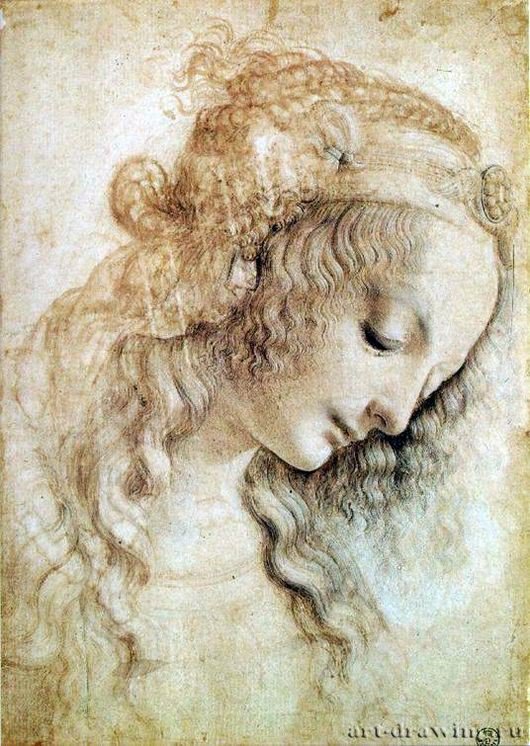
Leonardo Da Vinci is a great Renaissance artist. The most important feature of his work is that he conveyed human emotions in his paintings with incredible accuracy and expressiveness, carefully depicting absolutely everything, even the smallest details.
In order to complete the work, the great artist repeatedly made multiple sketches and sketches, thanks to which experts subsequently analyzed the artist’s work and drew appropriate conclusions.
The same goes for sketches. female faces. "Woman's Head" was made using a silver pencil and red chalk on pink prepared paper. Some researchers and experts are inclined to believe that this drawing by Da Vinci is a sketch or sketch for a more famous painting"Madonna of the Rocks"
The painting shows a young woman in profile, with her head slightly tilted. Leonardo Da Vinci incredibly managed to convey her emotions: this is manifested in the girl’s eyes, the line of her lips and even in the hair that flows smoothly over her shoulders.
Many researchers have spent decades studying Da Vinci's paintings and works. It must be said that even now the disputes do not subside. However, most believe that the sketches, including the “Head of a Woman,” are sketches that the great artist made before creating a real work of art.
The sketches and sketches of Leonardo Da Vinci are of invaluable value as world heritage. In addition, sketches help experts understand what the great artist wanted to convey with his work, what he wanted to convey to future generations, and what he wanted to tell his descendants.
The artist left behind a huge number of works and paintings, which are stored in various art galleries and are the greatest value among other works of art.
The brilliant Italian artist Leonardo da Vinci created a whole series of masterpieces in his life. Thus, he perceived reality, learning it through his sketches and paintings.
The works of art that he created during his life still attract connoisseurs today. Thanks to his works, the art of painting moved to a new stage.
The list of works by Leonardo da Vinci includes especially significant works, which touched the souls of many people. For example, the painting “Madonna Litta”, completed in 1491. A young mother feeding her baby. The artist himself seems to identify the process of feeding with understanding the human soul. In the child’s hands we see a small bird – a red goldfinch. The image of the bird is shed blood, sacrifice and suffering, life for the glory of the Faith. The painting glorifies motherhood, as well as the modesty of a mother. Currently this work of art is in the Hermitage.
The painting “Madonna with a Carnation” is surrounded by many mysteries. It dates back to around 1478 and depicts a spiritual mother with a smile on her face and a carnation in her hands and active child who is trying to reach the flower. Leonardo's signature handwriting is already visible in this painting.
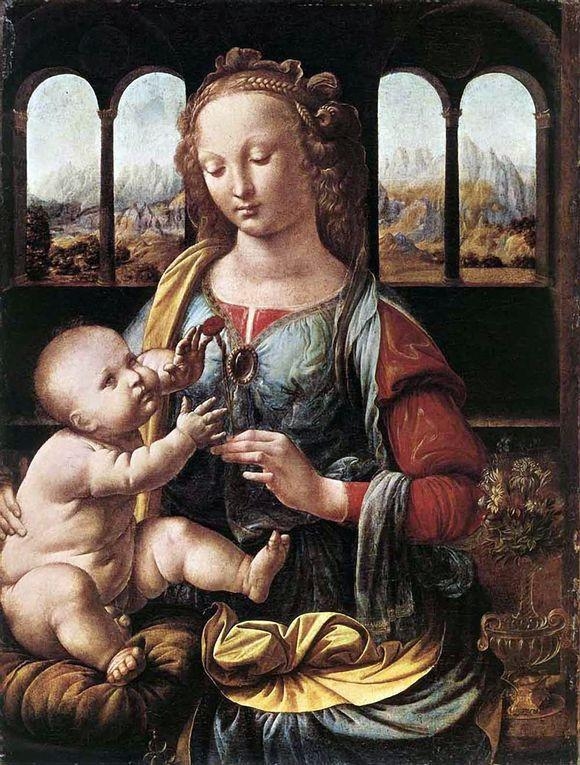
The poetess depicted with a sad expression on her face is the “Portrait of Ginevra de Benci.”
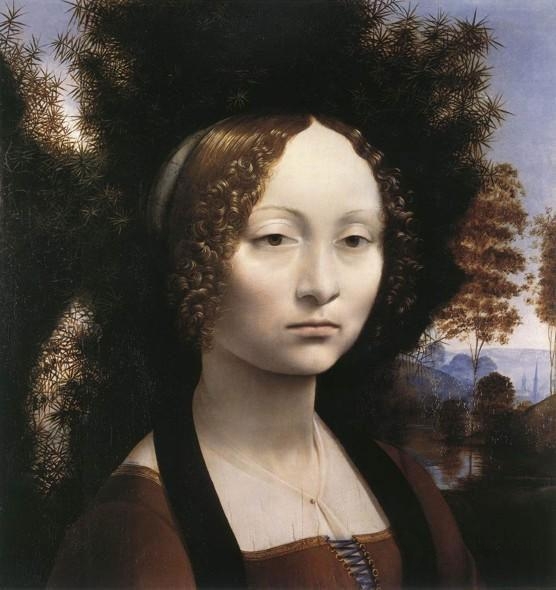
The artist often painted portraits of women, fully conveying the psychologism of their experiences.
Let's talk about selected works of the great Italian painter. His most famous works: “The Last Supper”, “Mona Lisa”, “Lady with an Ermine”, “Vitruvian Man”, “The Baptism of Christ”.
"The Last Supper" reveals deep human experiences in religious themes. Jesus and his 12 disciples were painted in detail by Leonardo. The masterpiece began to deteriorate immediately, and restorers have been struggling for several centuries to “freeze” the work.
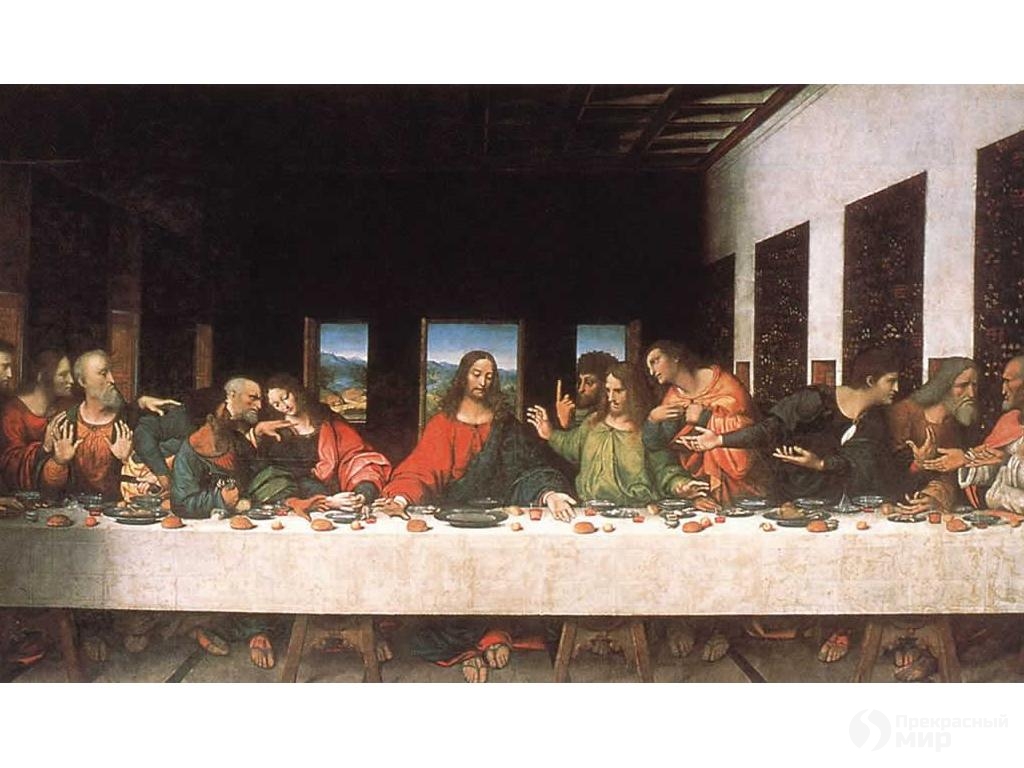
The painting “The Baptism of Christ” was created by Leonardo da Vinci together with Andrea del Verrocchio. It is believed that the student painted an angel on this picture, and did it so accurately that Andrea stopped using his brush. Angel is really different in its writing technique.
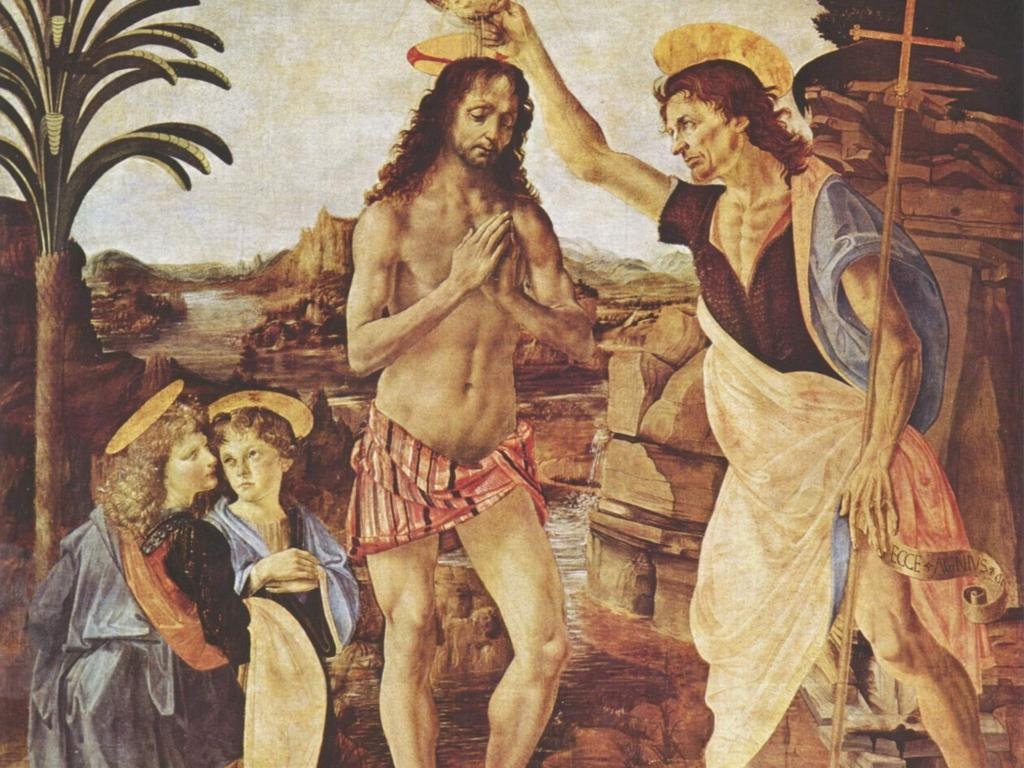
“Lady with an Ermine” is one of the most beautiful paintings in the world. Beautiful face a lady dressed in fashion, with well-drawn hands. She gracefully holds the animal, without restricting its movements at all. It is believed that the painting depicts one of the mistresses of the Duke of Sforza, Cecilia Gallerani, but there is no documentary evidence.
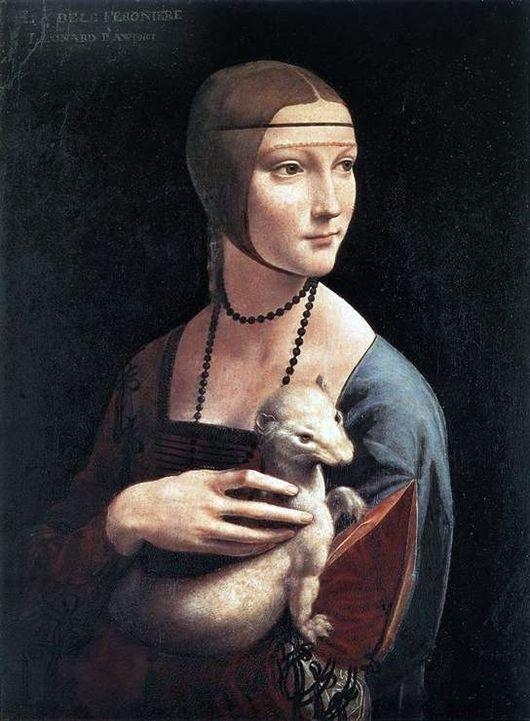
“The Vitruvian Man” was created as an illustration for an educational publication dedicated to the works of Vitruvius. A drawing that shows the ideal human form, dividing the male figure into two equal parts. This work is both a masterpiece of art and scientific work. « Golden ratio", which we use now, was invented by Leonardo da Vinci. There is a version that the author depicted himself, and to understand the picture itself, you need to carefully read the description of it.
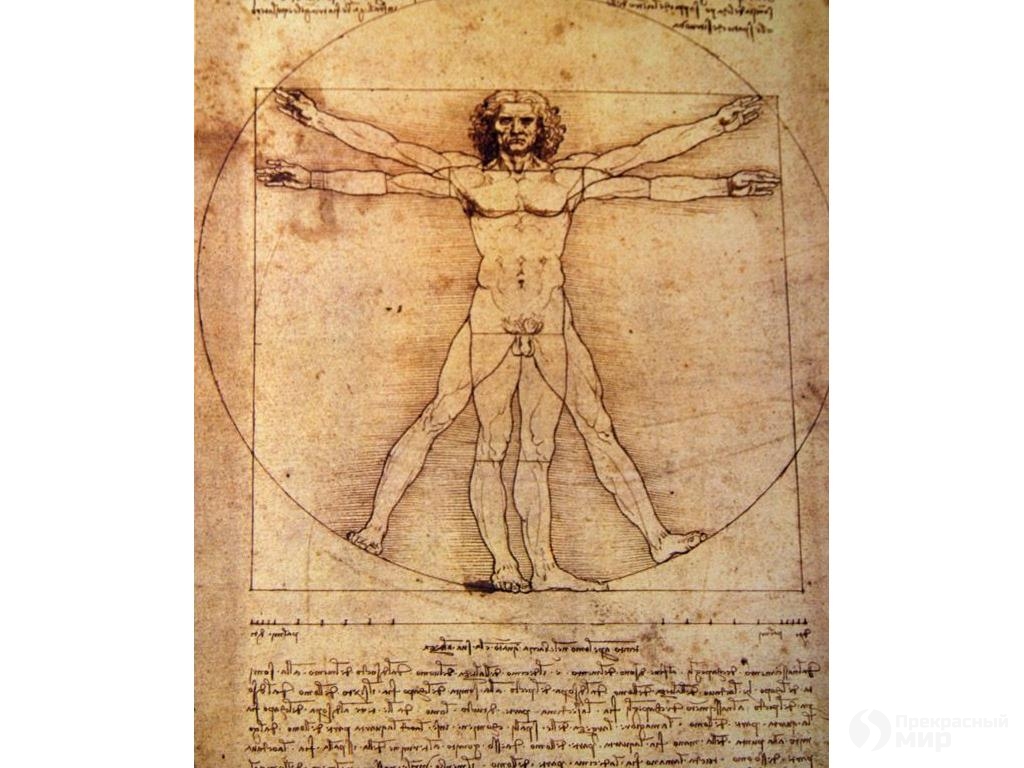
And finally, the most mysterious and mystical painting by Leonardo is the “Mona Lisa” (La Gioconda). It is still unknown who is depicted in this picture, although there are many guesses. This painting now hangs in the Louvre. Her mysterious smile is captivating, causing numerous controversies.

They say that hidden in the works of art of Leonardo da Vinci secret signs and encrypted esoteric codes that have not been solved for several centuries. But all over the world in museums we can find his paintings and admire how the Italian master painted them!












Surveyor. Who is a surveyor? Description of the profession. Profession surveyor Surveyor training
Magellanic clouds: who are they?
Pepper Steak Sauce Creamy Pepper Sauce
How to create a competent portfolio for a designer
If you dreamed that a house burned down - interpretation of the dream according to the dream book